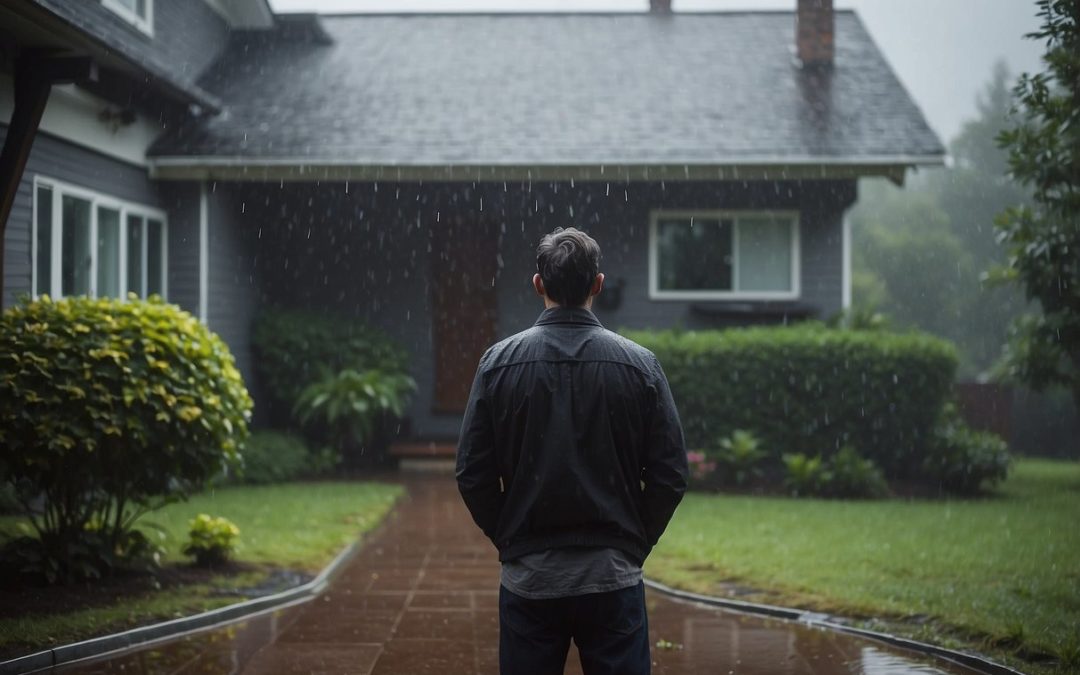Homeowners often find themselves asking if their home insurance policy covers roof leaks. This concern arises when they face unexpected expenses, such as damage to property or the need for pricey repairs. Understanding the extent of coverage offered by your home insurance policy is crucial, as it helps homeowners make informed decisions and take necessary precautions. So does home insurance cover roof leaks?
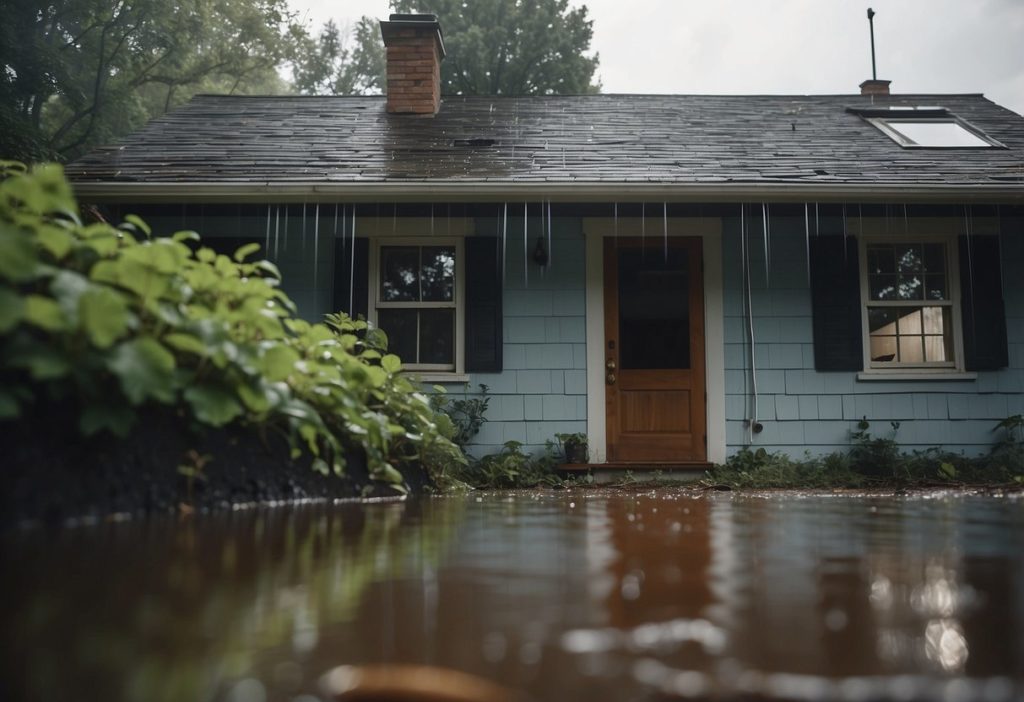
In general, home insurance policies provide coverage for roof leaks, but the specifics depend on the terms and conditions of each policy. The factors influencing coverage typically include the leak’s cause, the roof’s age and condition, and the homeowner’s preventative maintenance efforts.
It’s important for homeowners to review their policies carefully to determine what is and isn’t covered. Some policies may only cover leaks resulting from specific causes, such as weather events or acts of vandalism, while others may provide more comprehensive coverage. Familiarizing oneself with these details can help homeowners avoid unpleasant surprises and take appropriate steps to maintain and protect their property.
Is Roof Damage Covered?
Typical Covered Scenarios
Home insurance generally covers roof damage caused by perils such as fire, lightning, windstorms, and hail. If these events result in damage to your roof, the insurance company is likely to cover the repairs. For instance, if a tree falls on your house during a windstorm, your home insurance policy should cover the roof damage, provided you have wind coverage in your policy.
- Fire and lightning
- Windstorms (including tree damage)
- Hail
The coverage includes damages to the structure of the roof, as well as any interior damages that may have occurred due to the roof leak, provided that the issue was addressed immediately and not the result of negligence.
Exclusions and Exceptions
Several scenarios and causes of roof damage are typically excluded from home insurance policies. These include, but are not limited to:
- Earthquakes
- Settling, rust, or fungus
- Mould
- Normal wear and tear
- Intentional damage
- Government action
For example, if your roof experiences minor leaks or damage as a result of aging or normal wear and tear, the insurance company is unlikely to cover the repairs. Additionally, damage caused by settling, rust, and fungus fall under the category of maintenance issues and are generally excluded from coverage.
If your roof is damaged due to an earthquake, most policies do not provide coverage, and you would need to purchase separate earthquake insurance. Similarly, if roof damage is intentional or caused by a government action, your home insurance policy will not cover the repairs.
It’s important to familiarize yourself with your home insurance policy to understand the extent of coverage provided for your roof, including any limitations or exclusions. In some cases, it may be necessary to purchase additional coverage to ensure adequate protection for your home.
Understanding Home Insurance Coverage
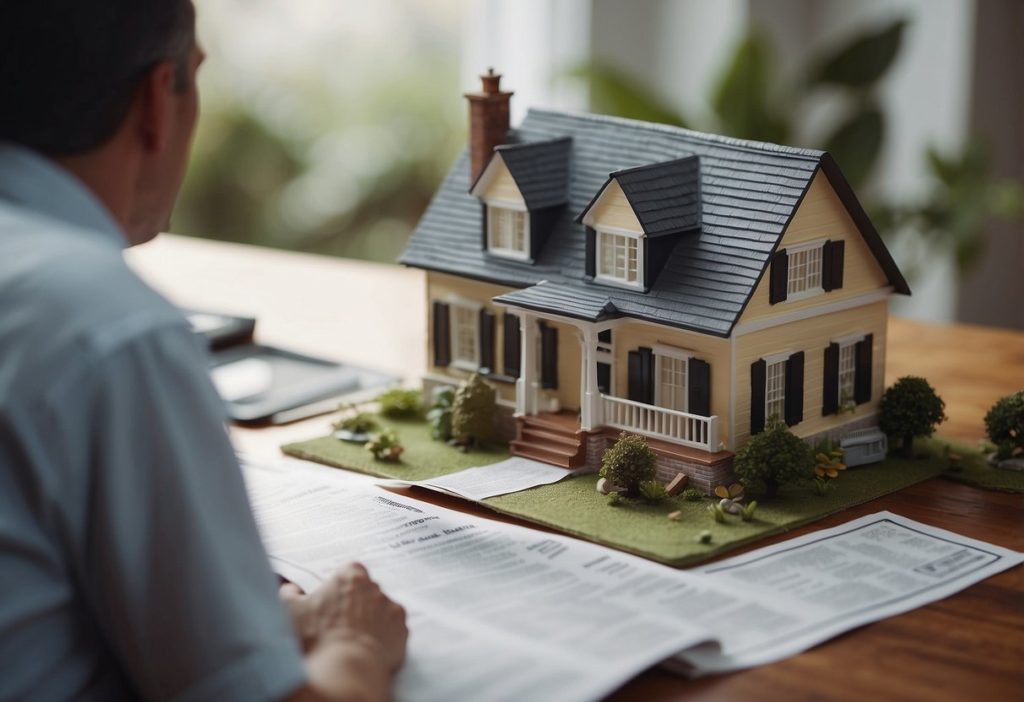
Insurance Policy Basics
Homeowners insurance is a type of insurance policy that provides financial protection for your home and its contents from various risks, such as theft, fire, or natural disasters. The insurance policy consists of a premium, the amount you pay for the policy and the coverages that detail the specific protection provided. The policy can have inclusions, which are the covered perils, and exclusions, which are the non-covered perils.
Types of Home Insurance
There are different types of home insurance policies called broad form policies. This policy typically offers a combination of broad form and named perils coverage. Open peril policies cover all risks except those specifically excluded, while named peril policies only cover the risks explicitly listed in the policy. Here’s a brief overview of the coverage offered by broad-form policies:
| Coverage | Description |
| Dwelling Coverage | Covers the physical structure of your home |
| Other Structures | Covers structures on your property not attached to your home |
| Personal Property | Covers your belongings |
| Loss of Use | Covers additional living expenses if your home is uninhabitable |
| Personal Liability | Covers legal expenses in case of injury to others on your property |
| Medical Payments to Others | Covers medical costs for injured guests |
What Are Covered Perils?
Covered perils are the specific risks and events that your home insurance policy protects you against. Examples of common covered perils in a broad form policy include:
- Fire and smoke damage
- Theft or vandalism
- Wind or hail damage
- Explosion
- Damage from vehicles or aircraft
- Falling objects
- Weight of snow, ice, or sleet
It’s crucial to understand that not all perils are covered in a standard homeowners insurance policy. For example, damage caused by floods or earthquakes is usually not included. In such cases, you may need to purchase additional coverage known as an endorsement to protect your home against those specific risks.
Common Causes of Roof Leaks
Various factors can cause roof leaks. Understanding the common causes can help homeowners determine the best course of action for preventing and addressing these issues. This section covers three main reasons for roof leaks: weather-related damage, aging and deterioration, and maintenance issues.
Weather-Related Damage
Extreme weather conditions can have a significant impact on the integrity of a roof. Strong winds can dislodge shingles or other roofing materials, exposing the underlying structure to water damage. Moreover, heavy snow or ice accumulation can put undue stress on the roof, leading to leaks or even collapse.
Hail can also cause small dents or punctures in roofing materials, resulting in leaks over time if not promptly repaired. Finally, heavy rainfall or storms may exploit existing vulnerabilities in the roof, causing leaks to emerge or worsen.
Aging and Deterioration
Roof leaks can often be attributed to the natural aging process and eventual deterioration of roofing materials. As the materials break down due to wear and tear and exposure to the elements, their ability to effectively protect from water intrusion diminishes.
For instance, asphalt shingles or wood shingles typically have a lifespan of 20 to 30 years. Once they surpass their expected lifespan, they become more susceptible to leaks and damage.
| Roofing Material | Expected Lifespan |
| Asphalt Shingles | 20-30 years |
| Wood Shingles | 20-30 years |
| Metal Roofs | 40-60 years |
Maintenance Issues
Another major cause of roof leaks is neglect or lack of maintenance. Routine inspection and maintenance are crucial for maintaining the health of your roof and addressing any underlying issues before they worsen. Issues that result from inadequate maintenance include:
- Clogged gutters: Overflowing gutters can cause water to seep under roofing materials, resulting in leaks.
- Debris accumulation: Leaves, branches, and other debris can trap moisture against the roof, gradually causing damage.
- Damaged or missing flashing: Flashing is used to seal seams and edges of a roof. If it becomes damaged or dislodged over time, it can lead to leaks.
In summary, roof leaks are commonly caused by weather-related damage, aging and deterioration, and poor maintenance. By understanding these factors, homeowners can take measures to minimize the risk of leaks and maintain the integrity of their roofs.
Filing a Roof Leak Insurance Claim
Steps to File a Claim
- Contact your insurance company immediately: Inform them of the roof leak and request guidance on the claims process. Remember to keep note of any deadlines for filing a claim.
- Assess the damage: Inspect the damage yourself and take photos as visual evidence. This will be helpful when filing the claim.
- Temporary repairs: To prevent further damage, perform emergency repairs if safe and within your capability. Keep the receipts for the repairs as these might be reimbursed by the insurance company.
- Professional roof inspection: Hire a licensed professional to inspect the roof for causes and extent of the damage. The inspection report will serve as additional proof during the claims process.
- Prepare documentation: Gather all necessary documentation, including photos, receipts, and the roof inspection report.
- File a claim: Submit the required documentation to the insurance company for their review and assessment.
Importance of Documentation
Proper documentation is vital when filing a roof leak insurance claim. The insurance company will require sufficient proof of damage to validate the claim. This may include:
- Photos of damage: Photographic evidence helps establish the extent of the damage and serves as a visual reference.
- Roof inspection report: A professional inspection report identifies the causes of the leak and provides an estimate of repair costs.
- Receipts: Keeping receipts for emergency repairs or subsequent damages can help justify reimbursement claims.
Dealing with Claim Rejections
If a claim is rejected, don’t panic. Consider the following steps:
- Review the rejection letter: Understand the reasons for the rejection as stated by the insurance company.
- Review your policy: Make sure you understand the coverage and exclusions, and determine if the rejection aligns with the terms of your homeowner’s insurance.
- Gather more documents: Strengthen your claim by gathering additional evidence or obtaining an independent assessment of the damage.
- Appeal the decision: Present the supplementary documentation and clearly explain any discrepancies between the rejection letter and your policy to the insurance company.
- Seek professional help: If the claim rejection stands despite your appeals, consider seeking legal advice or hiring a public adjuster to help with the process.
Remember, thorough documentation and a comprehensive understanding of your homeowner’s insurance policy are essential for successfully filing a roof leak insurance claim.
Repairing Roof Leaks
Roof leaks can cause significant damage to your home, including mould growth, structural damage, and damaged ceiling and drywall. Repairing a roof leak can be a challenging task, but taking the right steps can help you prevent further damage and keep your home protected.
Temporary vs. Permanent Repairs
When dealing with a roof leak, it’s important to understand the difference between temporary and permanent repairs. Temporary repairs, such as using a tarp or patching material, can provide a short-term solution until a professional can assess the damage and provide a more permanent fix.
- Temporary repairs:
- Use a tarp to cover the affected area
- Apply patches or sealing products on small cracks or holes
- Ensure proper ventilation in the attic to prevent mold growth
- Permanent repairs:
- Replace damaged or missing shingles
- Repair or replace cracked or damaged gutters
- Install additional insulation and ventilation in the attic
Professional Roofing Services
Hiring a licensed insurance professional is essential when dealing with roof leaks, as they can accurately assess the damage, suggest the best course of action, and execute the necessary repairs. These professionals can:
- Find the source of the leak
- Assess any structural damage, such as damaged studs or drywall
- Remove and replace damaged shingles, gutters, or other materials
- Provide preventative measures to avoid future leaks
Preventative Measures
Routine inspections and maintenance are key to preventing roof leaks. By taking these steps, you can help extend the life of your roof and avoid expensive repairs or replacements.
- Routine inspection: Regularly inspect your roof, including after heavy storms or changes in season. Look for damaged or missing shingles, cracks, and debris clogging the gutters.
- Debris removal: Remove any debris, such as leaves and branches, from the roof and gutters to prevent buildup and damage.
- Gutter maintenance: Ensure gutters are properly installed, free of cracks, and sloped for proper drainage.
- Attic ventilation: Proper ventilation in the attic can help prevent mould growth and extend the life of your shingles.
By taking these preventative measures and hiring a professional when necessary, you can help protect your home from roof leaks and the damage they can cause.
Impact on Homeowners Insurance Premiums
Claims and Premium Rates
When a homeowner files a claim for a roof leak, it can directly impact their insurance premiums. Insurance companies often reassess the risk associated with a policyholder after a claim has been filed. A higher risk typically results in higher insurance premiums for the homeowner. In some cases, it may even lead to a policy non-renewal, forcing the homeowner to seek insurance from another provider.
In addition to the potential increase in insurance premiums, the homeowner may also need to pay a deductible before the insurance company covers the cost of repairs. Deductibles can range from $500 to $2,000, depending on the policy and the specifics of the claim.
Homeowners need to understand the terms of their insurance policy, as some policies might not cover certain types of roof leaks, leaving the homeowner responsible for the entire cost of repairs. A policy with guaranteed replacement cost coverage can help a homeowner avoid paying out-of-pocket for devalued materials due to depreciation.
Cost-Benefit Analysis of Claims
Homeowners should carefully weigh the pros and cons of filing a claim for a roof leak. The potential long-term increase in insurance premiums and the upfront deductible cost may make it more economical to cover the repair expenses without involving the insurance company.
A good starting point is to obtain a professional estimate of the repair costs from a reputable contractor, such as those found on the Angi platform. Compare the estimated repair costs with the deductible, and factor in any potential increases in insurance premiums over time.
If the repair costs are significantly higher than the deductible, filing a claim may be necessary and beneficial. However, if the costs are comparable to the deductible, it might be more cost-effective for the homeowner to cover the repair expenses independently and avoid making a claim, thus keeping their insurance premiums from rising.
In summary, homeowners should consider the potential impact on their homeowner’s insurance premiums and weigh the costs and benefits before filing a claim for roof leaks. Understanding their policy coverage and closely analyzing the financial implications can help homeowners make a well-informed decision.
Additional Coverage Options
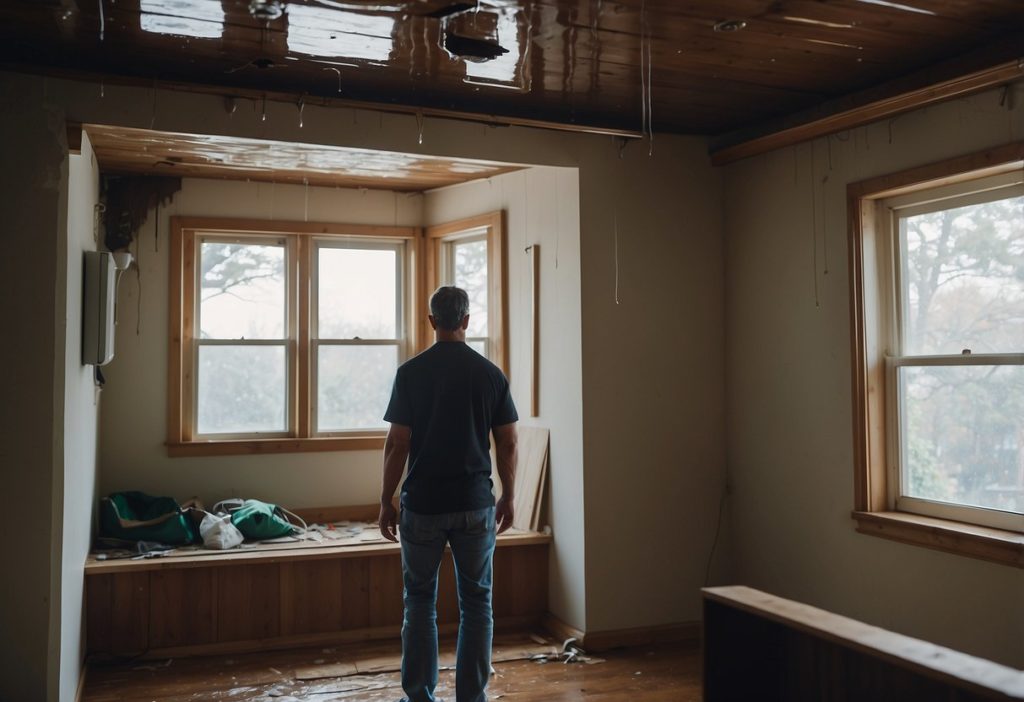
Specialized Insurance Policies
Some situations may require specialized insurance policies. This is often the case when the standard homeowner’s insurance policy does not provide adequate coverage for specific events or catastrophes. For instance, policies typically exclude floods, landslides, and earthquakes, which could result in a roof leak.
- Flood Insurance: Regular home insurance policy generally excludes coverage for damages caused by floods. Homeowners located in flood-prone areas may need to consider purchasing separate flood insurance.
- Earthquake Insurance: Similarly, standard policies usually exclude coverage for damage caused by earthquakes. In areas prone to seismic activity, purchasing earthquake insurance becomes necessary.
- Wind Coverage: In regions prone to windstorms and hurricanes, specialized wind coverage can help protect homeowners from roof leaks and other damages caused by strong winds.
Endorsements and Add-ons
Endorsements and add-ons can enhance a standard homeowners insurance policy to expand the scope of coverage and address specific needs. Some popular endorsements and add-ons for roof leaks include:
- Weight of Ice, Snow, or Sleet: This add-on coverage can protect homeowners from damage caused by the build-up of ice, snow, or sleet on the roof.
| Coverage | Exclusions | Cost |
| Protection against damage caused by ice, snow, or sleet build-up | Natural disasters, intentional damage, wear and tear | Varies depending on location and extent of coverage |
- Vandalism and Malicious Mischief: This endorsement can cover damages caused to the roof by acts of vandalism or theft.
| Coverage | Exclusions | Cost |
| Protection against roof damage caused by vandalism and theft | Damages caused by homeowner, coverage limits | Varies depending on location and claim history |
- Sinkholes and other catastrophic earth movements: This add-on coverage can help protect homeowners from roof leaks caused by sinkholes, mudslides, or land subsidence.
| Coverage | Exclusions | Cost |
| Protection against roof damage from sinkholes, mudslides, and land subsidence | Natural wear and tear, intentional damage | Varies depending on location and risk factors |
It is essential for homeowners to examine the fine print of their policies and discuss potential endorsements and add-ons with their insurance agents to tailor their coverage to their specific needs. By understanding the available options, homeowners can ensure they have adequate coverage against roof leaks and other potential damages.
Frequently Asked Questions
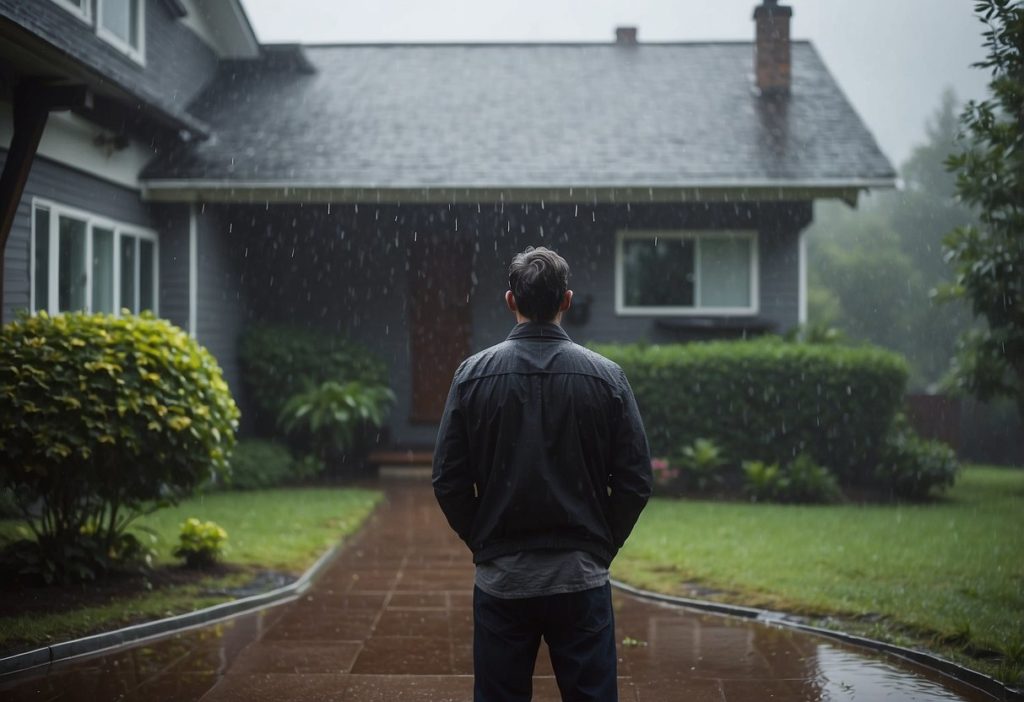
How can I ensure my insurance covers the cost of roof replacement?
To ensure your insurance covers the cost of roof replacement, it’s important to have a comprehensive home insurance policy that includes coverage for roof damage. Review your policy to understand the extent of coverage and any exclusions. Regular roof maintenance and timely repairs can also increase the likelihood of your insurance covering the costs.
What types of roof damage will my homeowner’s insurance generally cover?
Homeowners insurance generally covers roof damage caused by perils such as fire, windstorms, hail, lightning, and fallen trees. However, coverage may vary between policies and some insurers may exclude specific causes of damage. Check your policy or consult with your insurance provider for detailed information on what’s covered.
Under what circumstances will insurance cover water damage caused by rainfall?
Insurance will typically cover water damage caused by rainfall if it’s due to a sudden and unexpected event like a windstorm or hail that damages your roof. However, coverage may not extend to water damage resulting from poor maintenance or wear and tear.
Is damage from a leaking roof typically included in house insurance policies?
House insurance policies generally cover damage from a leaking roof if it’s caused by a covered peril like wind, hail, or a fallen tree. Damage resulting from wear and tear or lack of maintenance may not be covered. It’s crucial to maintain your roof and make necessary repairs promptly to ensure coverage.
In the event of a roof leak, should I immediately contact my insurance provider?
Yes, it’s essential to contact your insurance provider as soon as you discover a roof leak. This will enable them to guide you through the claim process and potentially send out an adjuster to assess the damage. Document the leak with photos and keep any receipts for temporary repairs to help the process go smoothly.
Are there any special considerations for roof leak insurance claims in Canadian policies?
Canadian policies may have specific requirements or exclusions related to roof leaks. For instance, some policies may have separate deductibles for wind or hail damage. Additionally, coverage levels can vary depending on your province and the specific insurance provider. Consult your policy or insurance provider for precise information about coverage in your area.
Will insurance cover a 20-year-old roof?
The coverage for older roofs may depend on the policy and insurance provider. Some insurers offer limited coverage or reduced payouts for roofs beyond a certain age, while others may exclude older roofs altogether. Check your policy or speak with your insurance provider to understand your specific coverage.
Will insurance cover a 15-year-old roof?
Similar to 20-year-old roofs, coverage for a 15-year-old roof will depend on the policy and insurance provider. Some insurers may offer full coverage or have specific limitations. Review your policy details and consult with your insurance provider for further information.
Do you need to tell insurance about a new roof?
Yes, it’s essential to inform your insurance provider about a new roof as it may impact your coverage and premiums. A new roof may qualify you for discounts or adjustments in your policy, so keeping your insurance provider informed is crucial to make the most of your policy.

